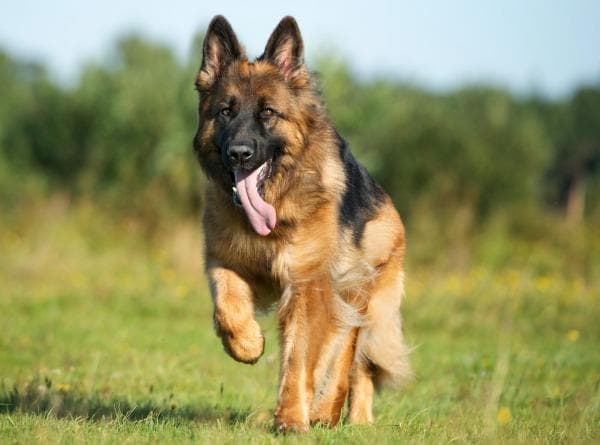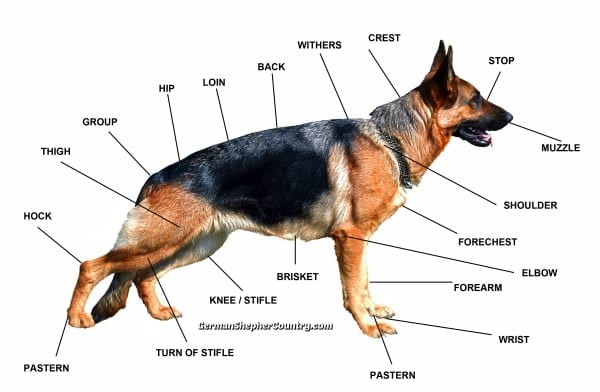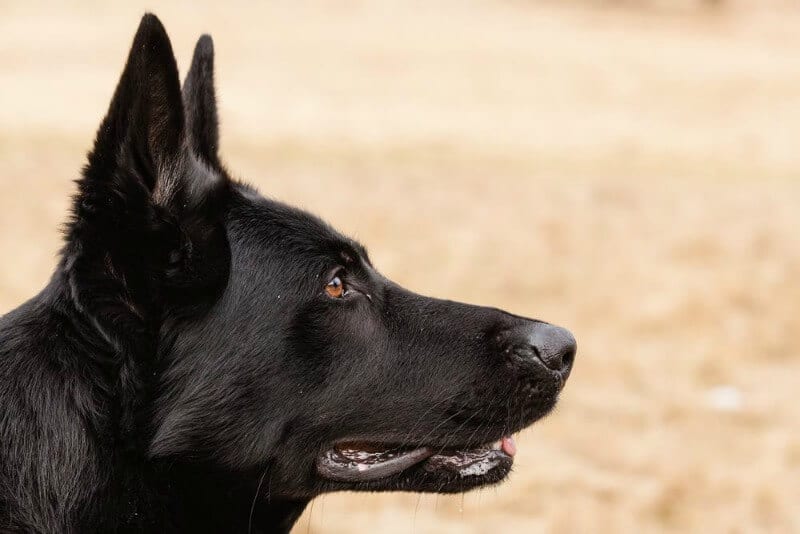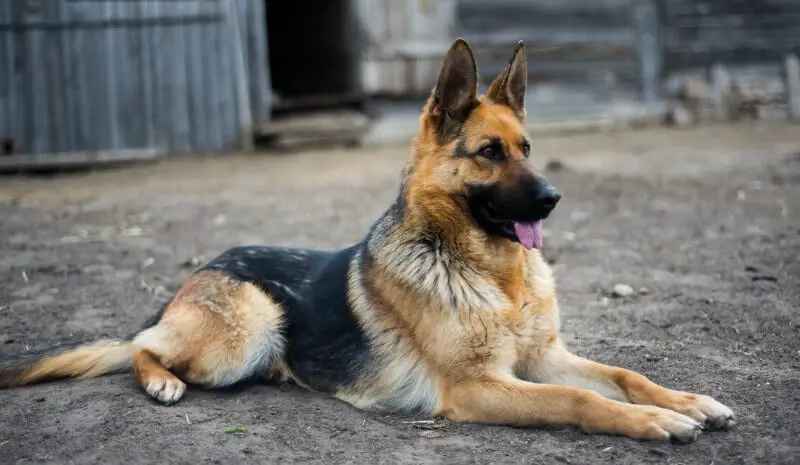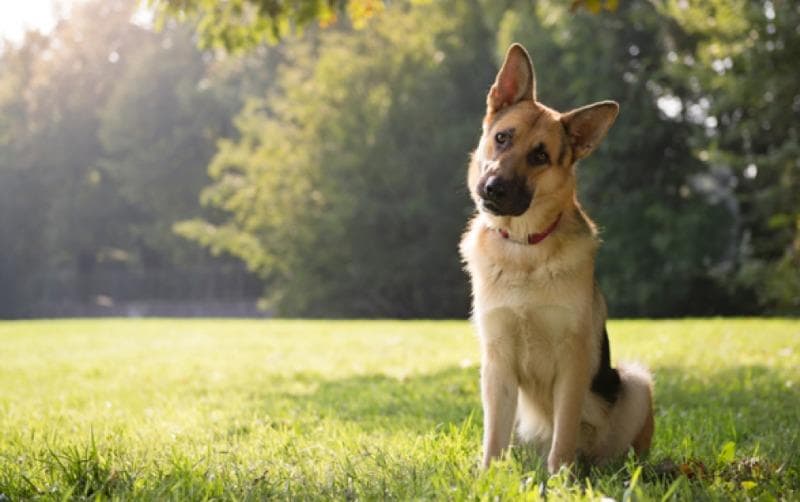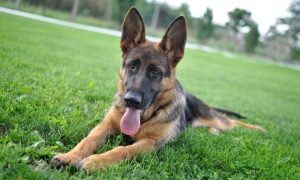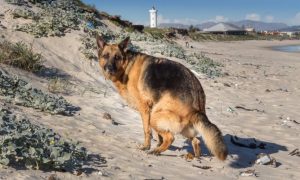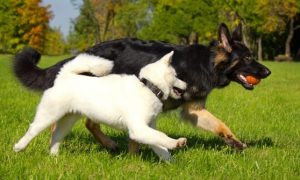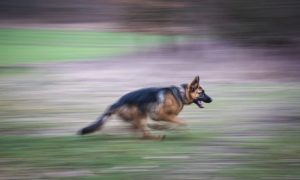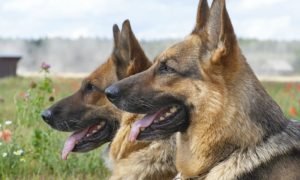Breed standard rules for the German Shepherd Dog were established on September 20, 1899, in Augsburg, Germany by Captain Max von Stephanitzthe and the organization, Verein für Deutsche Schäferhunde (Society for the German Shepherd Dog, “SV” for short).
German Shepherd Breed Standards: Size
The modern German Shepherd is a medium to large-sized breed that is athletic, strong, well-muscled, and has an overall proportionate and balanced appearance.
The German Shepherd Dog is one breed that should definitively look masculine or feminine. Males are taller, heavier, and squarer through the face. Females are shorter, lighter, and narrower through the face and muzzle area.
The Breed Standard dictates the following ideal height and weight requirement for a GSD:
Males
- 23–26 inches (60–65 cm) tall at the withers
- Weight between 66–88 lbs. (30-40 kg)
* Withers – the ridge between a dog’s shoulder blades and the tallest point of their body.
Females
- 21-24 inches (55-60 cm) tall at the withers
- Weight between 49–71 lbs. (22-32 kg)
* Height and weight are approximate
The standard calls for the above heights and weights to help keep the GSD built for work, health, longevity, and performance.
The standard size German Shepherd will be more athletic, have more endurance, have fewer joint issues due to weight, be a better sport or working dog, and have an easier time just getting around in general.
German Shepherd Breed Standards: Characteristics
The German Shepherd Dog should be well-balanced, firm in nerves, self-confident, utterly calm and impartial, and (except in tempting situations) amiable.
They must possess courage, willingness to fight, and hardness to be suitable as a companion, watchdog, protector, service dog, and guardian.
They have a wedge-shaped head that is large but in proportion to the body and a forehead that is domed; these dogs have an elongated square-cut muzzle with lips that are tight against the teeth and dark in color, and a nose that is large, wide and black.
The jaws on these dogs are strong; they have a bite that can be compared with a scissor-like cut.
The eyes of the German Shepherd are medium in size, almond-shaped, and sparkling brown with an intelligent look that is self-assured.
The ears are generally large and always stand erect; they are open at the front and parallel but are frequently pulled back throughout the movement.
The necks on these dogs are long, and it is lifted when they become excited, lowered when moving at a fast pace.
The German Shepherd’s tail is bushy and fairly long. The shoulders slope into a straight, strong back, and movement is effortless and long, with a smooth trot.
German Shepherd Breed Standards: Coat Types
The German Shepherd breed has three coat variations, according to the WUSV (World Union of German Shepherd Dog Clubs). They are:
1. Stock Coat
2. Long Stock Coat
3. Long Hair
German Shepherd Stock Coat
The stock coat is the most common and familiar coat on the German Shepherd Dog. This coat is desired according to the standard and can vary from a very short fur to a plusher, thicker fur.
German Shepherd Long Stock Coat
This coat is most often referred to as a “coat” “coated” or “long coat.” A “long coat” has longer, fluffier fur with a thick undercoat.
They usually have fluffy fur around their ears and on the back of their legs and are traditionally beautiful animals.
Some German Shepherd owners prefer the appearance of a coated shepherd over a stock coat Shepherd.
The long coat gene is a simple recessive gene, thus making coated dogs somewhat rarer. Both parents are required to be coated or carry the recessive gene in order to produce long coated puppies.
Even after many years of carefully planned breeding, a few coated puppies are occasionally born into a stock coat litter.
Hardcore breeders are not happy when a coated puppy appears in a litter and will try to breed this out of their kennel’s bloodline.
Long hair puppies pop up from two stock coated dogs because each parent is carrying the recessive gene.
A lot of breeders will not breed these two dogs again. Both of these dogs could be bred to different mates who do not carry the gene, and both could potentially produce litters without any coated offspring.
As a buyer, a coated puppy can be an indication that the whole litter is going to be a good one. This is because the sires and dams who have produced the offspring are carriers of strong genetics from their ancestors.
Puppies with this recessive gene generally have a strong-boned body structure, are exceptionally good-natured, and are of sound character.
There is no correlation between a dog’s coat and working ability.
It is not uncommon to see police and military service dogs that are coated. This is because the coated shepherd can be purchased for less money–yet it still has the genetics, heart, and drives to fill the requirements of the job and the handler.
A German Shepherd’s coat length boils down to personal preferences. Just be prepared to defend your coated German Shepherd’s heritage, as a lot of people will mistake it for a mixed breed or a wolf hybrid.
German Shepherd Long Hair
A true “long hair” coated German Shepherd Dog is very rare. It has long silky fur with no undercoat. The hair parts down the middle of the back and flows down the sides of the dog.
Most people have never seen or heard of this rare coat.
Perception of the long-coated shepherd varies across standards; AKC deems them as faulty. Long coats are recognized by the German Kennel Club and the United Kingdom Kennel Club. The WUSV/SV has approved long stock coat dogs to be bred and shown. In the past, they were allowed to participate in Schutzhund but were disqualified from the show ring and breeding.
Regardless of region or organization, a German Shepherd dog is disqualified from breeding if there is no undercoat.
What If Your German Shepherd is not Within Breed Standards?
The official standards for 163 recognized breeds are maintained by The American Kennel Club (AKC).
An example of another organization that recognizes and adheres to standards of the German Shepherd Dog is The United Schutzhund Clubs of America (USCA).
If you’re not planning on being the next Westminster Kennel Club Dog Champion or breeding your dog, does it matter if your German Shepherd is not within Breed Standards?
Maybe it does aesthetically to some people, but remember that breed standards are guidelines.
A GSD that is too small, too big, has a white toenail or a floppy ear, doesn’t make them any less healthy, loving, loyal, or devoted.

